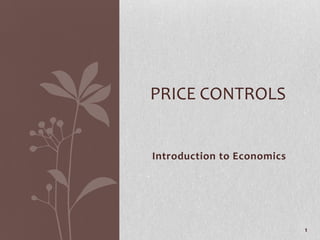
Price Controls
- 1. PRICE CONTROLS Introduction to Economics 1
- 2. Minimum Wage (Price Floor) • Making employers pay workers for more than the value of their work/production Results: • Fewer jobs; higher unemployment Cannot gain experience/skills • Raises the expectations of others • Retaliate: Discrimination Fewer benefits → Ineffectiveness of the system 2
- 3. Rent Control (Price Ceiling) • Making landlords lease their apartments at a rent below its real value Results: • Less construction • Deterioration/abandonment • Retaliate: Discrimination Key money Lower quality; less maintenance • Judicial/bureaucratic costs → More homelessness 3
- 4. Any Solution? •Yes, make the markets more competitive •Government intervention/regulation only reduces efficiency and does not achieve its intended objectives Competitive equilibrium: Lowest price Highest quantity Best quality Competition = recognizing the incentives Government intervention = ignoring the incentives4